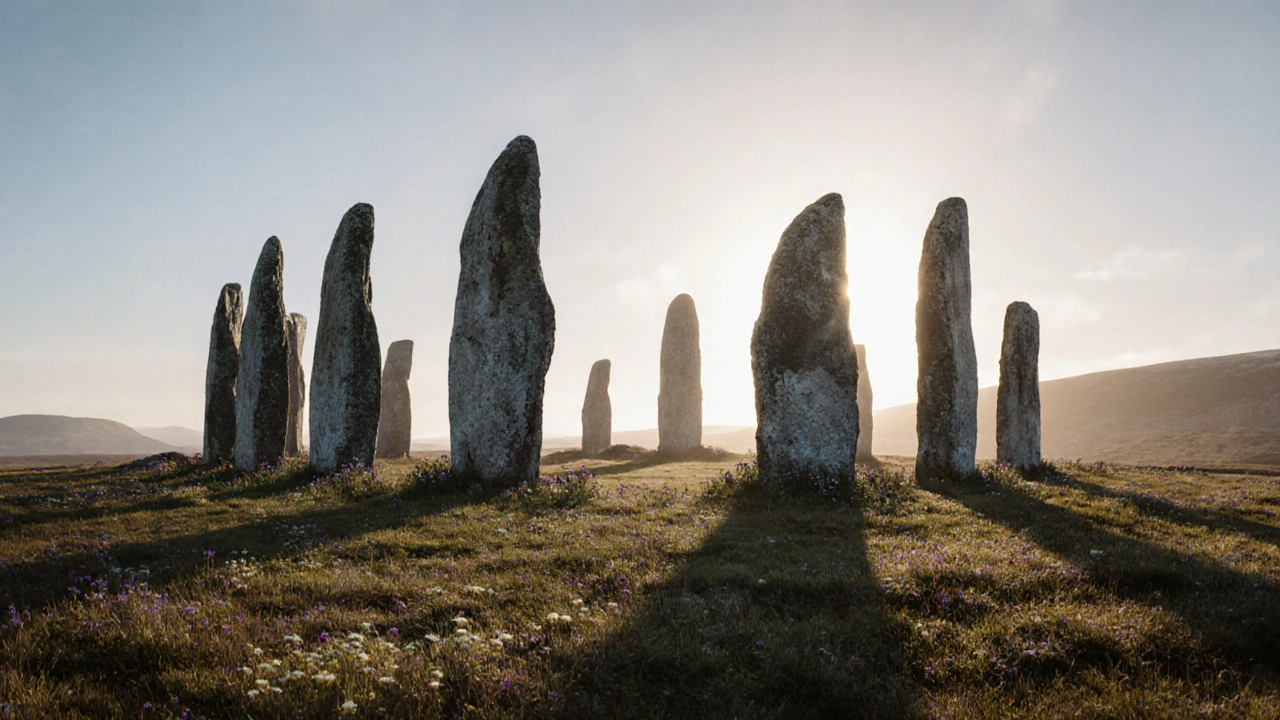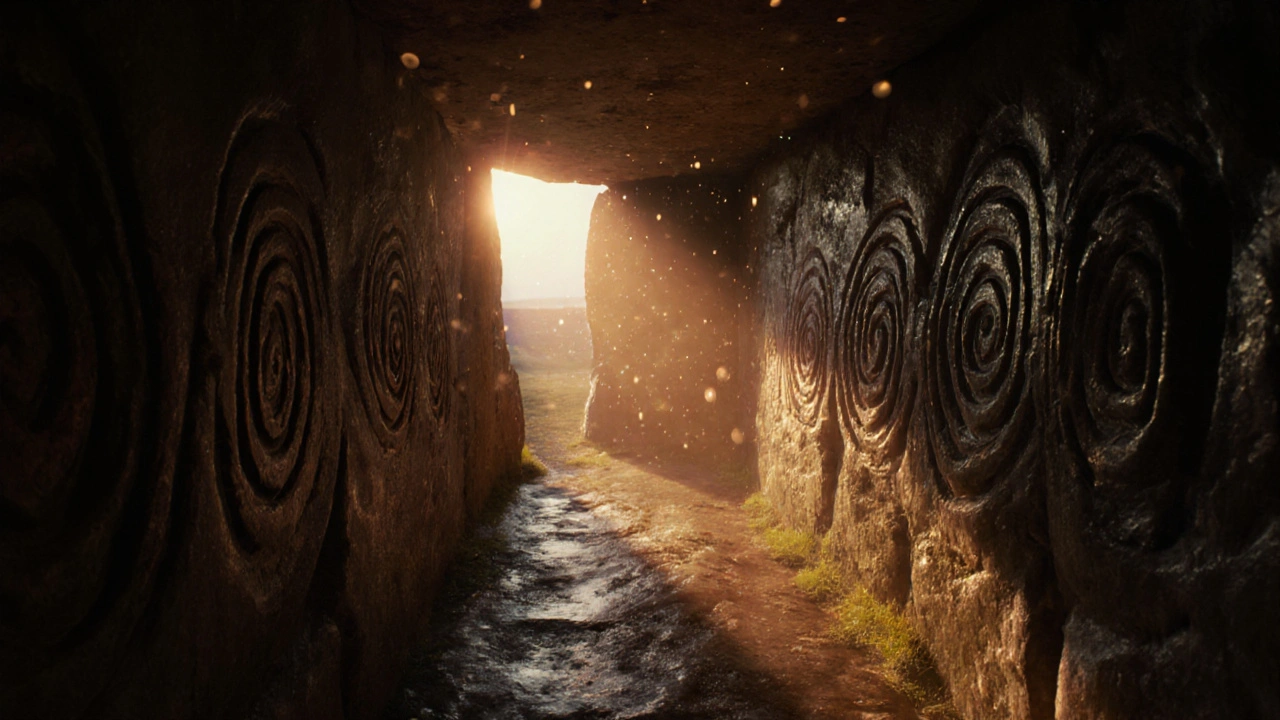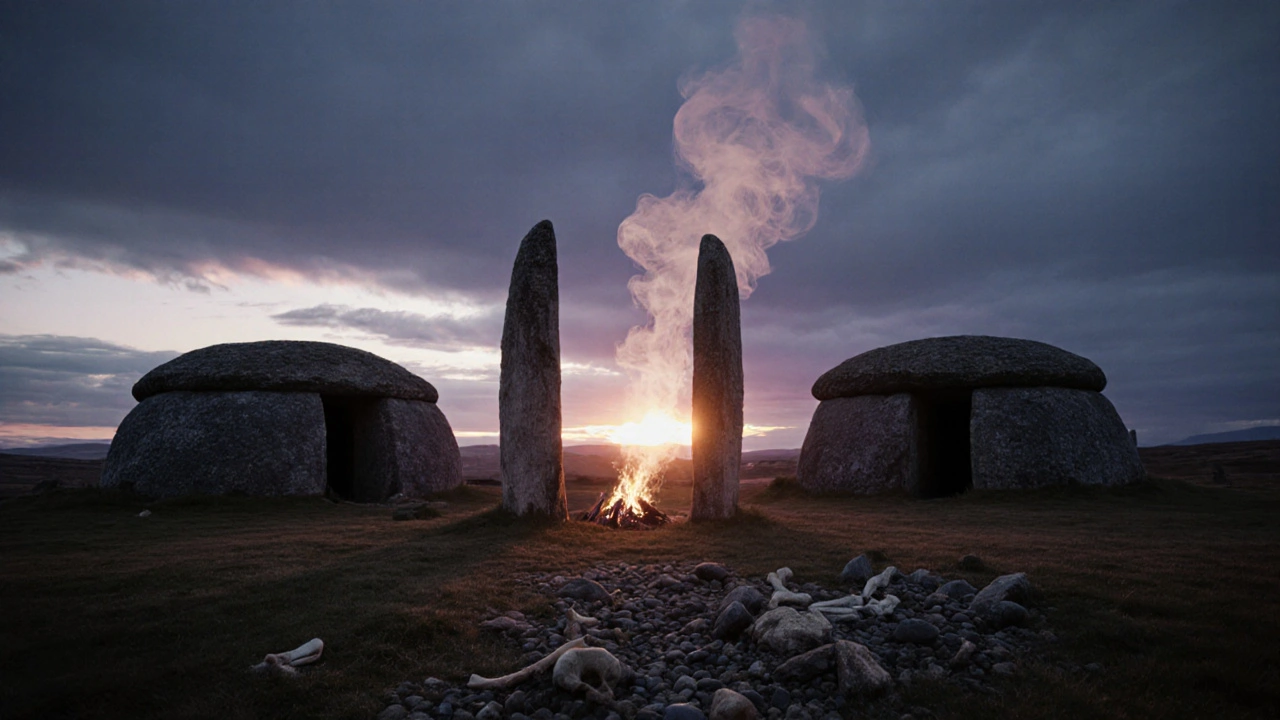
Walk through the Scottish highlands on a misty morning, and you might stumble upon a row of massive stones standing silent against the sky. No signs. No tickets. Just stone, wind, and centuries of silence. These aren’t random rocks. They’re the last breath of people who lived here over 5,000 years ago - before writing, before metal tools, before kings. The Neolithic and Bronze Age Scotland landscape is dotted with these monuments, and they’re not just relics. They’re clues.
Who Built These Stones?
The first people to leave lasting marks on Scotland’s land were Neolithic farmers, arriving around 4000 BCE. They didn’t have metal. They moved stones weighing up to 30 tons using ropes, wooden sleds, and sheer human effort. These weren’t random acts. Every stone placement had meaning. Some aligned with solstices. Others faced ancestral burial mounds. Some formed circles that echoed the movement of the sun and stars.
At Maeshowe in Orkney, a 5,000-year-old chambered cairn, the winter solstice sun slides down a narrow passage and lights up the back wall. That’s not luck. That’s engineering. That’s astronomy. That’s a society that tracked seasons with enough precision to plan a construction project that took generations.
These weren’t primitive tribes. They were organized communities with specialized roles - builders, astronomers, ritual leaders. Their tools were stone, bone, and wood. Their knowledge was passed down orally. Their monuments were their libraries.
The Standing Stones: More Than Monuments
The most famous of these are the standing stones. But not all standing stones are the same. There are single menhirs, stone rows, stone circles, and complex alignments. Each type served a different purpose.
The Callanish Stones on Lewis form a cross-shaped layout of 13 upright stones, with a central circle and a long avenue pointing toward the northern horizon. Archaeologists think it was used for seasonal rituals, possibly tied to lunar cycles. The stones were quarried from distant hills, dragged miles across rough terrain, and erected with perfect balance. No mortar. No nails. Just gravity and precision.
At Avebury in England, you’ll find a bigger circle. But in Scotland, the stones feel more intimate. More connected to the land. At the Stones of Stenness in Orkney, you can still see the sockets where the original stones stood. Some are missing - broken, pulled down by later farmers, or taken for building materials. But the ones left still hum with presence.
These aren’t just tourist spots. They’re sacred spaces. People still come to sit by them, to touch them, to feel something they can’t explain. Maybe it’s the weight of time. Maybe it’s the silence. Or maybe, just maybe, the stones still remember.
Bronze Age Shifts: From Stones to Swords
By 2200 BCE, things began to change. Metal arrived. First copper, then tin, then bronze - an alloy that made stronger tools and weapons. The people who came after the Neolithic farmers didn’t abandon the old ways. They layered new beliefs on top of them.
Bronze Age sites show a shift. Burial mounds became more individual. Cists - small stone coffins - replaced large communal tombs. Cremation replaced inhumation. And instead of building giant stone circles, people started placing single stones near burial pits or marking routes with small uprights.
The Clava Cairns near Inverness are a perfect example. Three circular cairns, each with a passage leading to a central chamber. Outside, standing stones frame the entrances. The winter solstice sun sets directly between two stones at the western cairn. This wasn’t just a grave. It was a calendar. A doorway. A way to connect the dead with the returning light.
Unlike the Neolithic, where communities worked together on massive projects, Bronze Age society seemed more fragmented. Smaller groups. More focus on individual status. Weapons buried with men. Jewelry with women. The stones still stood, but the meaning shifted. From collective memory to personal legacy.

Key Sites You Can Visit Today
You don’t need to be an archaeologist to walk among these sites. Scotland protects them well. Many are free to visit, open year-round, and accessible by short walks from parking areas.
- Maeshowe (Orkney) - A Neolithic tomb aligned with the winter solstice. Only accessible via guided tour due to preservation needs.
- Callanish Stones (Lewis) - A cross-shaped stone circle with a dramatic hill backdrop. Best visited at sunrise or sunset.
- Stones of Stenness (Orkney) - One of the oldest stone circles in Britain. Still surrounded by the original ditch.
- Clava Cairns (Inverness) - A quiet, well-preserved Bronze Age cemetery with clear passage tombs and standing stones.
- Avebury (England) - Not in Scotland, but often compared. Scotland’s circles feel wilder, less restored, more alive.
Bring a map. Wear sturdy shoes. The weather changes fast. And if you’re there at dawn or dusk, you’ll understand why these places still feel powerful.
Why Do These Sites Still Matter?
These stones aren’t just old. They’re proof that humans have always looked up and wondered. They built monuments not to show power, but to make sense of time, death, and the sky. They didn’t have GPS, but they knew where the sun would rise on the longest day. They didn’t have calendars, but they marked the year with stone.
Today, we measure time in seconds and stream history in videos. But when you stand at Callanish, and the wind cuts through the stones, you feel something deeper. A connection. A reminder that we’re part of a much longer story.
These sites survived wars, plagues, and centuries of forgetting. They weren’t preserved by museums. They were preserved because people kept coming back. Because they mattered.

What’s Still Unknown?
Despite decades of study, big questions remain. Why were some stones carved with spiral patterns? What did the people chant or sing during ceremonies? Were the stones seen as living entities? We don’t know.
Recent ground-penetrating radar scans under the Stones of Stenness revealed buried pits and postholes - signs of even older structures beneath the stones. That means the site was used for centuries before the stones were even raised.
At the Ring of Brodgar, soil samples show traces of barley and animal bones. This wasn’t just a ritual space. It was a gathering place - maybe a marketplace, a festival ground, a meeting point for clans from across the islands.
We’re still uncovering layers. Every year, new discoveries rewrite small parts of the story. The past isn’t fixed. It’s alive - waiting to be understood.
How to Respect These Sites
These aren’t theme park attractions. They’re fragile. They’re sacred. And they’re protected by law.
- Don’t climb on stones. The erosion from thousands of hands and boots is real. Some stones are already cracked.
- Don’t remove anything - not a pebble, not a leaf. Even a single stone moved can break a centuries-old alignment.
- Don’t use metal detectors. It’s illegal and destroys context.
- Stay on paths. The ground around these sites often hides buried archaeology.
- Take photos, but don’t use drones without permission. They disrupt wildlife and the quiet.
Leave nothing but footprints. Take nothing but memory.
What Comes Next?
Scotland’s ancient sites are more than history. They’re part of a living culture. Local communities still hold events at Callanish and Maeshowe. Schools bring kids to touch the stones. Artists paint them. Musicians play music near them. The past isn’t locked away. It’s still breathing.
If you want to understand Scotland, don’t just visit castles and whisky distilleries. Go where the land remembers. Stand where the first farmers stood. Look up. Listen. The stones are still talking.
Are the standing stones in Scotland really that old?
Yes. The oldest standing stones in Scotland, like those at Stenness and Callanish, date back to around 3000 BCE - over 5,000 years ago. That’s older than Stonehenge’s main circle and 2,000 years before the pyramids of Giza were finished. These were built by Neolithic farming communities who had no metal tools, writing, or wheeled transport.
Can you visit these sites all year round?
Most are open year-round and free to access. Some, like Maeshowe, require timed entry tickets due to limited space and preservation needs. Winter visits offer fewer crowds and dramatic lighting, especially around the solstice. Summer brings longer days but more visitors. Always check local conditions - weather can make paths muddy or inaccessible.
Why don’t we know what the stones were used for?
There’s no written record from the people who built them. Everything we know comes from archaeology - the layout of the stones, what’s buried nearby, animal bones, tools, and plant remains. We can guess based on alignments and comparisons with other cultures, but we can’t know their exact beliefs or rituals. That’s part of what makes them powerful - they hold mystery.
Is there a difference between Neolithic and Bronze Age sites?
Yes. Neolithic sites (4000-2500 BCE) focus on large communal structures like stone circles and chambered cairns. Bronze Age sites (2200-800 BCE) are more individual - single standing stones, small cists, and burial mounds. The shift reflects a change from collective society to more family- or individual-centered rituals.
Are there any guided tours available?
Yes. Sites like Maeshowe, Skara Brae, and the Ring of Brodgar offer official guided tours through Historic Environment Scotland. Local historians and archaeologists also lead small-group walks at Callanish and Clava Cairns. These tours give context you won’t get from signs alone. Book ahead in summer.
Comments (12)
-
John Fox November 17, 2025
Been to Stenness last winter. Zero people. Just me, the wind, and stones that felt like they were watching.
-
Franklin Hooper November 17, 2025
The alignment at Maeshowe isn't 'engineering' it's coincidental. Neolithic people didn't have the math for precise astronomical calibration. You're romanticizing ignorance. The solstice thing is a modern projection. Also, 'libraries' of stone? That's not even metaphorically accurate. They didn't have written language so how could they store knowledge in stone? This post reads like a National Geographic fanfic.
-
Jess Ciro November 19, 2025
They didn't build these. The Anunnaki did. Look at the weight of those stones. Human hands couldn't move them without alien tech. The spirals? That's ancient alien writing. The UK government knows this. They cover it up because they're in cahoots with the Illuminati. I saw a drone footage from 2019 where the stones glowed at midnight. They deleted it. I still have the original file.
-
saravana kumar November 20, 2025
These sites are overrated. I've seen better megaliths in India. Harappan civilization had urban planning 2000 years before these stone circles. And you call them 'primitive'? Please. The Indus Valley had sewage systems. These Scottish folks were just stacking rocks. Also, why is everyone pretending this is unique? The megaliths in Kerala are older, bigger, and nobody talks about them. It's colonial bias. You're celebrating European 'mystery' while ignoring Asian sophistication.
-
Tamil selvan November 21, 2025
I must express my profound appreciation for the thoughtful, meticulously researched content presented here. The nuanced distinction between Neolithic communal architecture and Bronze Age individualized burial practices is not only academically sound, but emotionally resonant. The preservation of these sites reflects a moral imperative we must uphold - not merely as tourists, but as stewards of human heritage. May we never forget that every stone was once a prayer.
-
Mark Brantner November 22, 2025
bro i went to callanish at 4am and it was like… the whole place was vibrating? i swear i heard whispering. i didnt bring a camera bc i was scared. also the guy at the parking lot told me the stones used to bleed when it rained. idk if thats true but i believe it. also i brought a rock home as a souvenir. not a big one. just a little one. chill out im not a vandal
-
Kate Tran November 24, 2025
the part about not climbing the stones? i did it once. regretted it instantly. felt like i was stealing something. now i just sit and stare. the silence there is different than anywhere else. like the air remembers what happened.
-
amber hopman November 24, 2025
Franklin, your 'coincidental alignment' take is so tired. You're ignoring the statistical probability of 17 solstice-aligned structures across the British Isles. That's not luck. That's cultural consensus. And you call it romanticizing? It's reverence. We don't need written records to understand intent. Look at the labor. Look at the placement. Look at the fact that they built them knowing they'd never see the full result. That's not ignorance. That's legacy.
-
Jim Sonntag November 25, 2025
Y'all are overthinking this. The stones are just old. They're not aliens, they're not magic, they're not a secret library. They're proof that humans have always wanted to leave something behind. Even if we don't know why, that doesn't make them less real. Also, Jim, I'm not mad, I'm just disappointed in the Anunnaki theory. Come on.
-
Deepak Sungra November 26, 2025
ok but why is no one talking about how the stones at Callanish look like they were placed by someone who was really drunk? like, the alignment is off by 7 degrees. and the guy who built them probably got kicked out of his tribe for being too obsessed with rocks. i mean, imagine dragging 30 tons of stone just to watch the moon? that's not spiritual. that's mental health crisis. also, i went there and the wind made me cry. i think the stones are haunted. or maybe i just need therapy.
-
Samar Omar November 28, 2025
One cannot help but be awestruck by the profound ontological implications of these megalithic formations - they represent not merely architectural feats, but existential declarations of a pre-literate civilization that dared to inscribe cosmological truth into the very bedrock of the earth. The spirals? They are not mere decoration - they are recursive symbols of cyclical time, encoded in dolerite and silence. To reduce them to 'ritual sites' is to commit epistemic violence against the sublime. I wept when I touched the central stone at Maeshowe. The air tasted of amber and forgotten prayers.
-
chioma okwara November 28, 2025
you guys are all wrong. the stones were built by atlanteans who escaped to scotland after their island sank. the spirals are maps to underwater cities. and the reason no one talks about it? because the british government owns the land and they're hiding the truth. i read it on a blog in 2012. the author had a degree. also, the stones are made of basalt, not granite. you all got that wrong. fix your facts.
